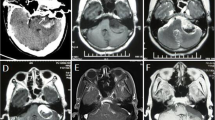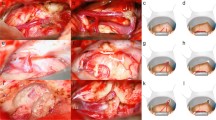Abstract
Although a majority of tumors in the Cerebellopontine Angle (CPA) are vestibular schwannomas (VS), other masses can also be seen in the region and differentiation of various CPA tumors, particularly meningiomas can be difficult on imaging alone. Treatment options may vary based on specific pathology of the CPA tumor. In this study, the presence of microhemorrhage (MH) and other imaging features such as size of lesion, cystic features and pattern of IAC extension, were evaluated as a tool in distinguishing VS from other CPA masses. A review of CPA masses in the last 11 years at our institution was performed. All the pathology proven tumors with at least 1 pre-operative MRI were considered for analysis. A T2* GRE or SWI sequence was used to assess presence of MH within the lesion. Pattern of IAC extension (‘centric’ versus ‘eccentric’) of tumor was also evaluated. A total of 147 patients were reviewed out of which 102 patients (with T2* GRE or SWI) were included for analysis of MH. 57 patients (56%) had VS as the final histopathological diagnosis and 45 patients (44%) had other types of tumor. A sensitivity of 82% and a specificity of 98% was noted for the presence of MH favoring the diagnosis of VS from other tumors (p < 0.001). All meningiomas with IAC extension (25/31) showed an ‘eccentric’ pattern of extension into the canal. Visualization of MH and pattern of IAC extension is useful in the differentiation of schwannomas from other CPA masses, particularly meningiomas.





Similar content being viewed by others
References
Bonneville F, Sarrazin JL, Marsot-Dupuch K, Iffenecker C, Cordoliani YS, Doyon D et al (2001) Unusual lesions of the cerebellopontine angle: a segmental approach. Radiographics 21:419–438
Heller RS, Silveira L, Heilman CB (2018) Cerebellopontine angle tumors. In: Principles of neurological surgery, 4th edn., pp 602–621
Grey P, Moffat DA, HardyDG, (1995) Surgical results in unusual cerebellopontine angle tumours. Clin Otolaryngol 21:237–243
Nakamura M, Roser F, Dormiani M, Matthies C, Vorkapic P, Samii M (2005) Facial and cochlear nerve function after surgery of cerebellopontine angle meningiomas. Neurosurgery 57(1):77–90
Tomogane Y, Mori K, Izumoto S, Kaba K, Ishikura R, Ando K, Wakata Y et al (2013) Usefulness of PRESTO magnetic resonance imaging for the differentiation of schwannoma and meningioma in the cerebellopontine angle. Neuro Med Chir 53:482–489
Samii M, Matthies C (1997) Management of 1000 vestibular schwannomas (acoustic neuromas): hearing function in 1000 tumor resections. Neurosurgery 40:240–260
McLendon R, Rosenblum M, Bigner D (2006) Russell & Rubinstein’s pathology of tumors of the nervous system, vol 2, 7th edn. CRC Press, Cleveland
Viswanathan A, Chabriat H (2006) Cerebral microhemorrhage. Stroke 37(2):550–555
Thamburaj K, Radhakrishnan VV, Thomas B, Nair S, Menon G (2008) Intratumoral microhemorrhages on T2*-weighted gradient-echo imaging helps differentiate vestibular schwannoma from meningioma. AJNR Am J Neuroradiol 29(3):552–557
Mishra A, Thomas B, Kapilamoorthy TR (2017) Susceptibility weighted imaging—a problem-solving tool in differentiation of cerebellopontine angle schwannomas and meningiomas. Neuroradiol J 30(3):253–258
Seo M, Choi Y, Lee S et al (2020) diagnostic value of susceptibility-weighted mri in differentiating cerebellopontine angle schwannoma from meningioma. Investig Magn Reson Imag. 24(1):38–45
Saravanan K, Parthasarathy EA, Abubacker SF, Sridharan P, Gopalakrishnan AR (2018) Role of susceptibility weighted imaging in cerebellopontine angle schwannoma vs meningioma. Int J Contemp Med Surg Radiol 3(2):B20–B23
Park C, Kim DC, Park SH, Kim JE, Paek SH, Kim DG et al (2006) Microhemorrhage, a possible mechanism for cyst formation in vestibular schwannomas. J Neurosurg 105:576–580
Gagliardo C, Martines F, Bencivinni F, La Tona G, Lo Casto A, Midiri M (2013) Intratumoral haemorrhage causing an unusual clinical presentation of a vestibular schwannoma. Neuroradiol J 26(30):34
Funding
Retrospective study-so consent is not needed. IRB was applied for and approved by the institution.
Author information
Authors and Affiliations
Corresponding author
Ethics declarations
Conflict of interest
The authors declare that they have no conflict of interest.
Ethical Approval
All procedures performed in the studies involving human participants were in accordance with the ethical standards of the institutional and/or national research committee and with the 1964 Helsinki Declaration and its later amendments or comparable ethical standards.
Informed Consent
No funding was received for this study.
Additional information
Publisher's Note
Springer Nature remains neutral with regard to jurisdictional claims in published maps and institutional affiliations.
Rights and permissions
About this article
Cite this article
Saigal, G., Pisani, L., Allakhverdieva, E. et al. Utility of Microhemorrhage as a Diagnostic Tool in Distinguishing Vestibular Schwannomas from other Cerebellopontine Angle (CPA) Tumors. Indian J Otolaryngol Head Neck Surg 73, 321–326 (2021). https://doi.org/10.1007/s12070-021-02372-8
Received:
Accepted:
Published:
Issue Date:
DOI: https://doi.org/10.1007/s12070-021-02372-8




